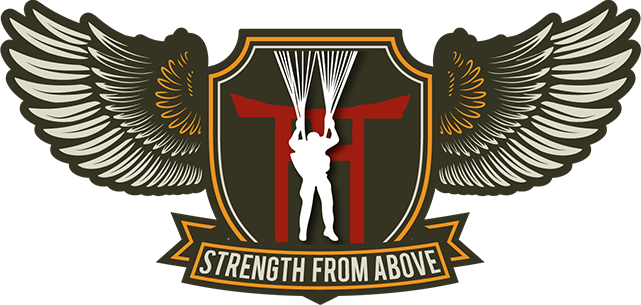Sgt. Kut, Peter Edward
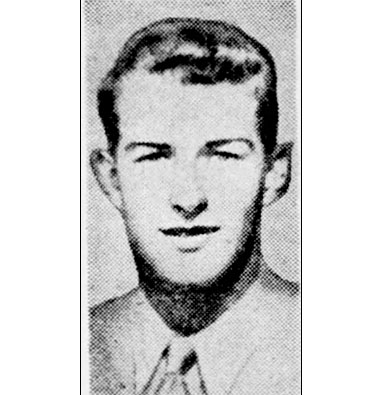
HQ2 Company, 511th PIR - KIA
April 4, 1922 - December 19, 1944 (Age 22) - Gravesite - Buried in Manila American Cemetery - Plot H, Row 1, Grave 871930
Citations: Combat Infantryman Badge (CIB), Purple Heart
Peter Edward Kut was born on April 4, 1922 in Philadelphia County, Pennsylvania to Peter W. and Helen Kut.
After completing only two years of high school, Pete met with his local Draft Board (Serial No. 49, Order No. T-11283) on June 20, 1942. At the time, the 6' 1" Pete was working for Kennedy & Britt – Jefferson, Masher & Howard, a textile manufacturing company in Philadelphia. When he enlisted as a Private in the United States Army on January 12, 1943, Pete weighed in at 174 lbs. and was described as having a light complexion, blue eyes and blond hair. He also had a scar on his nose, though I have as yet been unable to determine the cause of his scar. Some historians have attributed this scar to Pete's later boxing career in the service, which chronologically doesn't fit. If any readers are members of the Kut family and can instruct me in this area, please reach out to me via our Contact page.
Sgt. Kut married Margaretta G. Pale (1921-2018) on September 12, 1942 in Philadelphia and on July 7, 1943, their son Peter D. Kut was born. Sgt. Kut's new baby boy would only be nineteen months old when his father would be killed in action in December of 1944.
After enlisting in the Army and completing Basic Training, Pete volunteered for the new "parachute troops" and was assigned to the newly organized 511th Parachute Infantry Regiment (PIR) under the command of Colonel Orin D. "Hard Rock" Haugen. Pete was sent to Headquarters Company, 2nd Battalion, under Lieutenant-Colonel Norman Shipley.
As part of HQ2's 2nd Platoon, Private Kut would gone with the regiment to Camp Mackall, North Carolina in late March of 1943. Then in May, HQ2 headed for Fort Benning, Georgia to attend Jump School which Pete graduated and received his "Silver Badge of Courage." After Jump School, Pete and HQ2 returned to Camp Mackall and, now part of the 11th Airborne Division, the 511th PIR continued their advanced training until December when the division participated in the historic Knollwood Maneuvers which helped prove the validity of the complete airborne division to American's military and political leadership.
Pete and the 11th Airborne then moved to Camp Polk, Louisiana right after New Years for further training and maneuvers. The 11th Airborne in general, and Pete's 511th PIR in specific, proved their mettle time and time again during training and testing, but they also tested the patience of post authorities by their constant fighting with Camp Polk's armored units.
Luckily the 11th Airborne boarded a train in April of 1944 and headed west to Camp Stoneman which was located near Pittsburgh, California. After three weeks, on May 8, Pete and his buddies walked up the ramps of the SS Sea Pike, a converted Liberty Ship-type cargo ship that took the entire 511th PIR to Dobodura, New Guinea where Pete and the complete 11th Airborne Division became acclimated to the Pacific's jungle-and-mountain environment while also being held in Strategic Reserve for continuing operations in northern New Guinea.
Now, in addition to the seemingly never-ending training, the young paratroopers often got involved in the sports that were organized by Division. While football and baseball remained popular with the Angels, boxing was a co-favorite for the division, especially for Pete who joined the 511th's boxing team, though I have no evidence as to when.
Boxing had been almost a way of life in the 511th PIR since its formation at Camp Toccoa. The regiment's CO Col. Haugen fully believed the American proverb, “Train hard, fight easy.” His philosophy was that it was ok to be afraid, but it was never okay to run from a confrontation out of fear. As a child, Haugen was often teased by bullies, but the late bloomer never backed down, no matter how big his opponent was. Orin wanted his paratroopers to possess the same willingness to stand firm so under his direction, one of the first purchases the new regiment made at Toccoa was for fifty pairs of boxing gloves to increase athleticism and unit morale, plus teach the men to face their opponent with courage.
Again, I'm not sure when Pete became move involved with the boxing team, but I do know that while on New Guinea he became well-known within the regiment for his pugilistic prowess in matches with the Division's Artillery units (or "DivArty"), Special Troops, and the 187th and 188th Glider Infantries. And I should mention that prior to New Guinea, the 511th PIR's boxing team was only so-so, but Pete and his fellow paratroopers quickly became loathed by other units due to their skills in the ring.
The change came after Col. Haugen told Regimental HQ’s 1LT Foster D. "Punchy" Arnett to take over coaching the team and Hard Rock added that the 511th better start winning (Foster obediently won the New Guinea championship). Punchy had good stock to work with, they just needed some guidance which he famously provided. For example, D Company’s Pfc. William Dubes used his golden gloves to decimate opponents. During one match H Company’s Pfc. Jarrold T. “Jerry” Davis knocked a much larger opponent to the floor, twice, before winning decisively. E Company’s Pfc. Calvin “The Red Fox” Lincoln approached opponents with his left hand down before ending the match with his right. Fox Company’s Ted “The Walloper” Morrison just floored opponents and George Company’s Pfc. William P. Ransdell, the rookie of the ring, knocked out two Glider Riders with his first two punches as the 511th PIR roared.
Punchy Foster, who was also oversaw the Division Officers Mess, rewarded his champions like Pete Kut with steaks taken from the Division Staff’s personal store. Until the division's CO Major-General Joseph May Swing found out, that is, and irately had Punchy removed, adding, “Keep your damn boxers out of my mess hall.”
But the war continued, and the 11th Airborne Division was soon committed to combat. On November 11, 1944, 98 officers and 1296 enlisted men (including now Sergeant Pete Kut) of the 511th PIR departed Oro Bay, New Guinea aboard the Navy APA (Attack Personnel Transport), the "USS Golden City (AP-169)". There were 15 ships altogether in the convoy (task unit 79.15.1) bound for Leyte Island, Philippines and the 511th soon landed on 6,000-yard stretch of Bito Beach between Abuyog and Tarragona, forty miles south of Tacloban. A few days later the young paratroopers were sent into Leyte's jungles and mountains to find and eliminate the enemy's main supply line on the island, while also having to face elements of two Japanese divisions in the process.
I detail the regiment's incredible ordeal on Leyte in my book, WHEN ANGELS FALL: FROM TOCCOA TO TOKYO, THE 511TH PIR IN WORLD WAR II, but Pete was right in the middle of it all. He endured the hellish conditions, the enemy banzai attacks, the countless days of hunger, the sleepless nights, and the loss of dear friends who were killed in the cold calculations of combat.
This went on for just under three weeks when a battered and bloodied 2nd Battalion, along with Sgt. Kut's HQ2 Company, found themselves outside Mahonag. My grandfather, 1LT Andrew Carrico III and D Company had just come in from patrolling when at around 1900, 2nd Battalion's CO LTC Norman Shipley and another officer foolishly started a small but very visible fire to heat water for their Nescafe. Sgt. Kut's comrade Pfc. James Wentink of HQ2 saw the fire in the twilight as an unknown spotter plane flew overhead and screamed for the officers to put the fire out before he shot it (and them) out. Shipley, who some in 2nd Battalion felt was starting to “flake out”, sheepishly obeyed.
The next morning, December 18 (D+31 for the Angels), as 2/511’s column moved north at about 0900 it was violently shelled by artillery fire. Grandpa's D Company, who was just ahead of Fox Company on the trail, heard the shells roar in followed by explosions then screams (had the barrage happened minutes earlier, D Company would have been hit). HQ2-511 lost several men and Cpt. Charles A. Morgan reported that 10% of F Company was hit. LTC Shipley was seriously wounded in the leg and many in 2nd Battalion angrily blamed him for the whole incident as the spotter plane probably saw his fire the night before.
Pfc. James Wentink, who nearly shot Shipley for his fire the night before, said of the incident: “We lost some good guys, just because he was an idiot.”*
Regimental Surgeon Maj. Wallace E. Chambers, Battalion Surgeon Cpt. Matthew Platt and company medics saved many lives that day. One man whom the surgeons operated included the twenty-two year-old Sgt. Peter E. Kuts who had been injured quite severely by the artillery shelling. Battalion Surgeon Captain Matthew Platt amputated what was left of Pete's leg on the spot with a trench knife as Pete cried out for his wife Margie.
The wounded LTC Shipley was brought in to the aid area, shouting and whining loud enough to draw attention from every Japanese in the area as he demanded Cpt. Platt’s attention. Sgt. Kut, who lay panting on a stretcher, opened his eyes and said, “Aw, go ahead. Forget about me and take care of that big cry-baby.”
The surgeons did so, then the young Sergeant Peter Kut weakly called out to the men around him, “Say, let’s everybody bow our heads and have a moment of prayer.” Division chaplain Cpt. James O. Morman reported that the former prize fighter from Pennsylvania led the prayer as bloodied medics, troopers and surgeons bowed their heads. Kut then told them he was ready for the field hospital and Drs. Nestor and Platt organized poncho stretcher bearers from what was left of F Company to take the twenty-five wounded to Mahonag two hours away.
At the field hospital, Pete asked “Chappie” Morman to pray for his wounded captain, HQ2’s Cpt. Charles E. “Baldy” Jenkins, who unbeknownst to Peter had died in the shelling (96 paratroopers would die near Mahonag between December 3-24). Chaplain Jim remembered, “In all his agony (Pete) was interested in something else, thinking of how his captain was coming through.”
Interestingly, I found a Hospital Admissions Card for Pete that succinctly states: "First Location: Leg; Causative Agent: Artillery Shell, Fragments, A foot or unspecified."
Despite laboring all night, the surgeons were unable to stop the bleeding in his wounds and Sgt. Peter Kut passed away at 0400 the next morning (D+32). Words of his valor were sent to his wife, Margaretta Pale who was caring for their nineteen-month-old son, Peter.
“We laid him to rest temporarily in our little cemetery up on the side of the mountain,” recalled Kut’s friend, D Company’s Cpl. Murray Hale. Some in 2nd Battalion angrily argued that the young boxer could have been saved had the surgeons not been so busy tending to the bawling LTC Norman Shipley, a fact that only enflamed their animosity towards the officer.
Sgt. Peter E. Kut was first buried in a grave in the vicinity of where he met his death. After the campaign his body was disinterred and his remains were brought to 7740 USAF Cemetery, Leyte #1, Palo, Leyte, Philippines Islands – Grave 1449 (D-D No. 4646). The cemetery was located just outside the town of Palo, approximately eight miles south of Tacloban, Leyte Island. After the war his remains (along with 8,568 other American soldiers) were disinterred and brought to the American Graves Registration Service Manila Mausoleum. From there, according to the wishes of his wife, Margaret, Sgt. Peter E. Kut was buried in his final resting place in the Manila American Cemetery – Plot H, Row 1, Grave 87.
"Six Are Killed And 43 Wounded: Army and Navy Department casualty lists released yesterday and notifications to relatives contained the names of six men from Philadelphia area reported killed in action, 43 wounded, two prisoners of war and one missing.…Sergeant Peter E. Kut, 22, died Dec. 19 on Leyte of wounds suffered in action, the War Department notified his wife, Mrs. Margaretta Kut, of 3042 Salmon St. He was the father of a 19-month-old son. His parents live at 2960 Livingston St. He was inducted in January 1942."
- The Philadelphia Inquirer (Philadelphia, Pennsylvania), Saturday, 10 February1945, page 3.
I can only imagine how hard it was for Margaret Kut to answer the clerk helping her fill out the Application for Veterans Compensation when they asked, "How was the marriage terminated?"
On January 20, 1950, Margie simply answered: "Death."
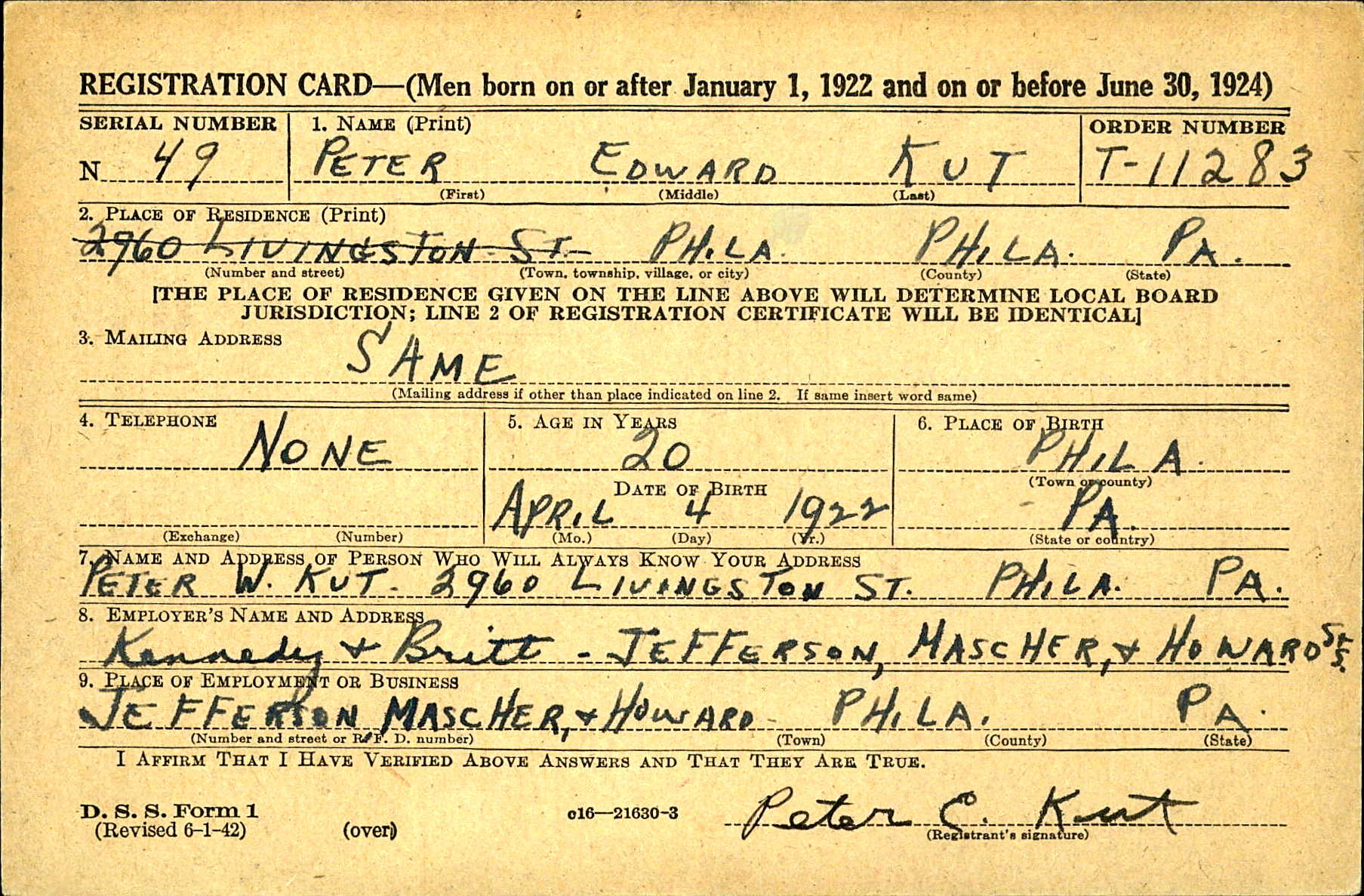
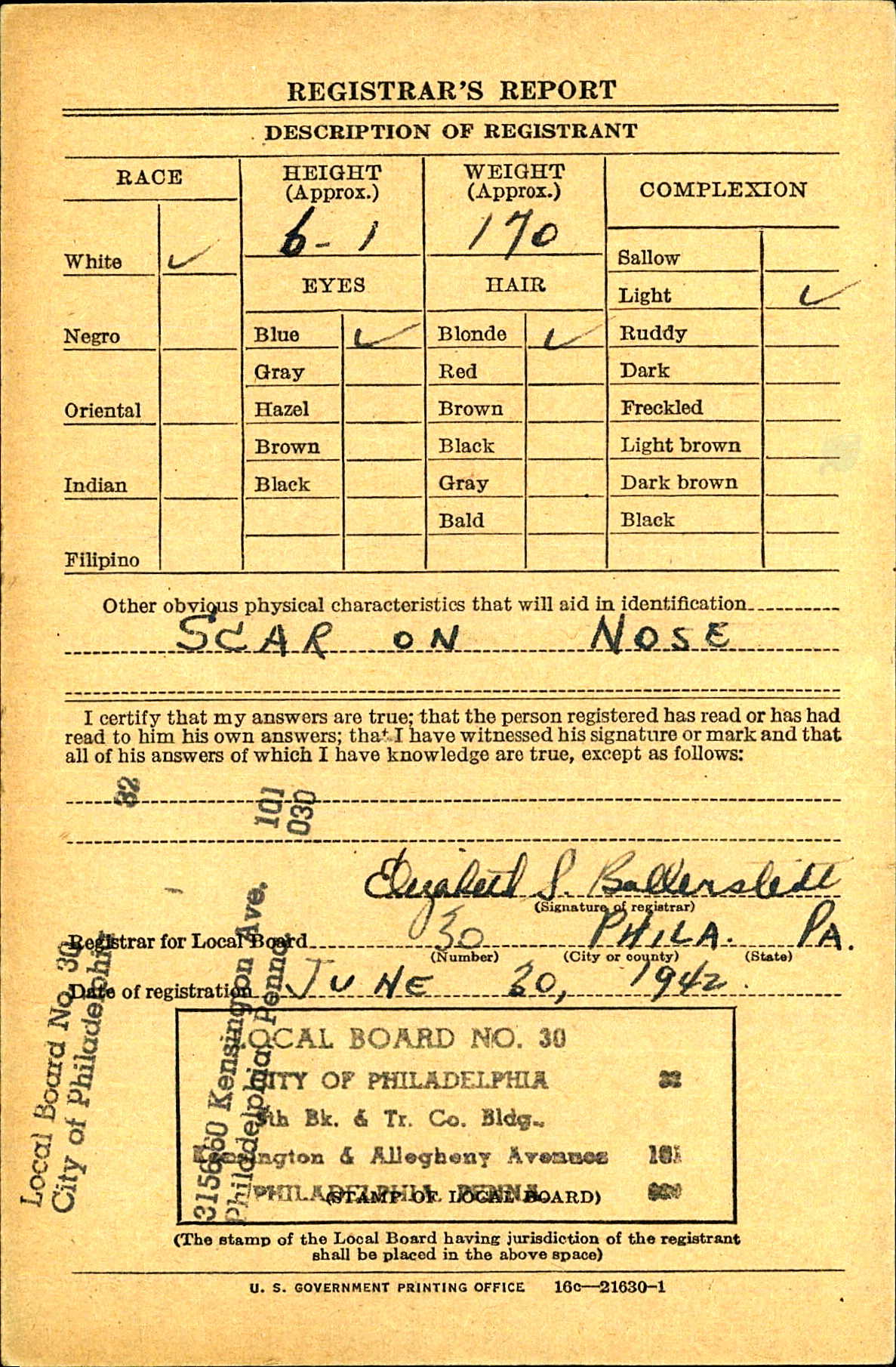
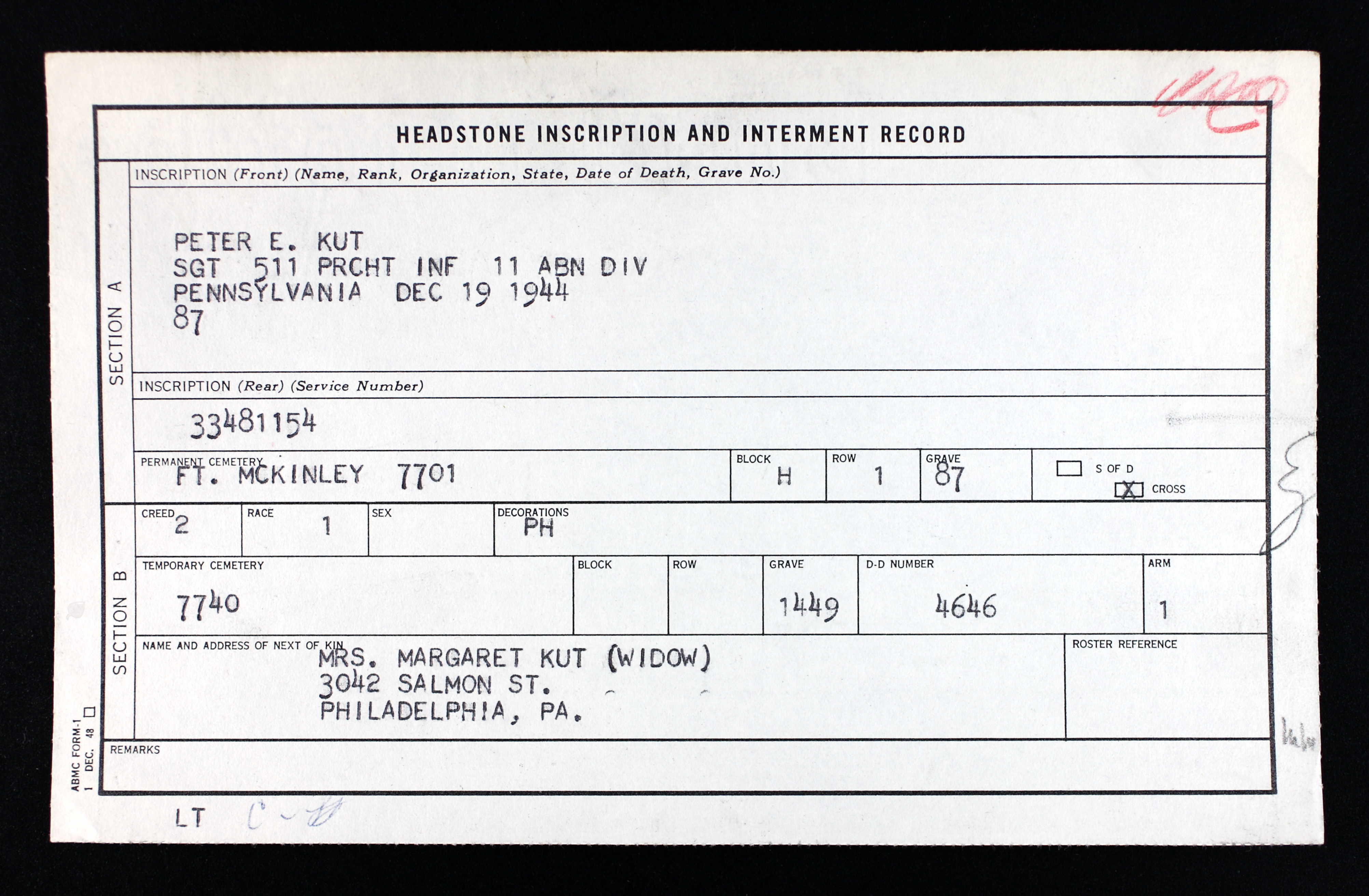
*The source of the six-round barrage that wounded Pete and the others outside Mahonag has been debated with many Angels believing they were from a Marine battery of 155s back on the Dulag beaches to the east. Arguments could also be made for Army guns on Ormoc Bay to the west and if either case is true, the carnage-causing shells may have ironically been unloaded by the Angels themselves during their time as stevedores on Bito Beach.
Perhaps the most likely culprit would be a nearby enemy 75mm gun that was visually sighted on 2nd Battalion’s column. Given the accuracy of the first three round burst and that the second was fifty yards ahead of the column, the Japanese probably had eyes on the Angels.
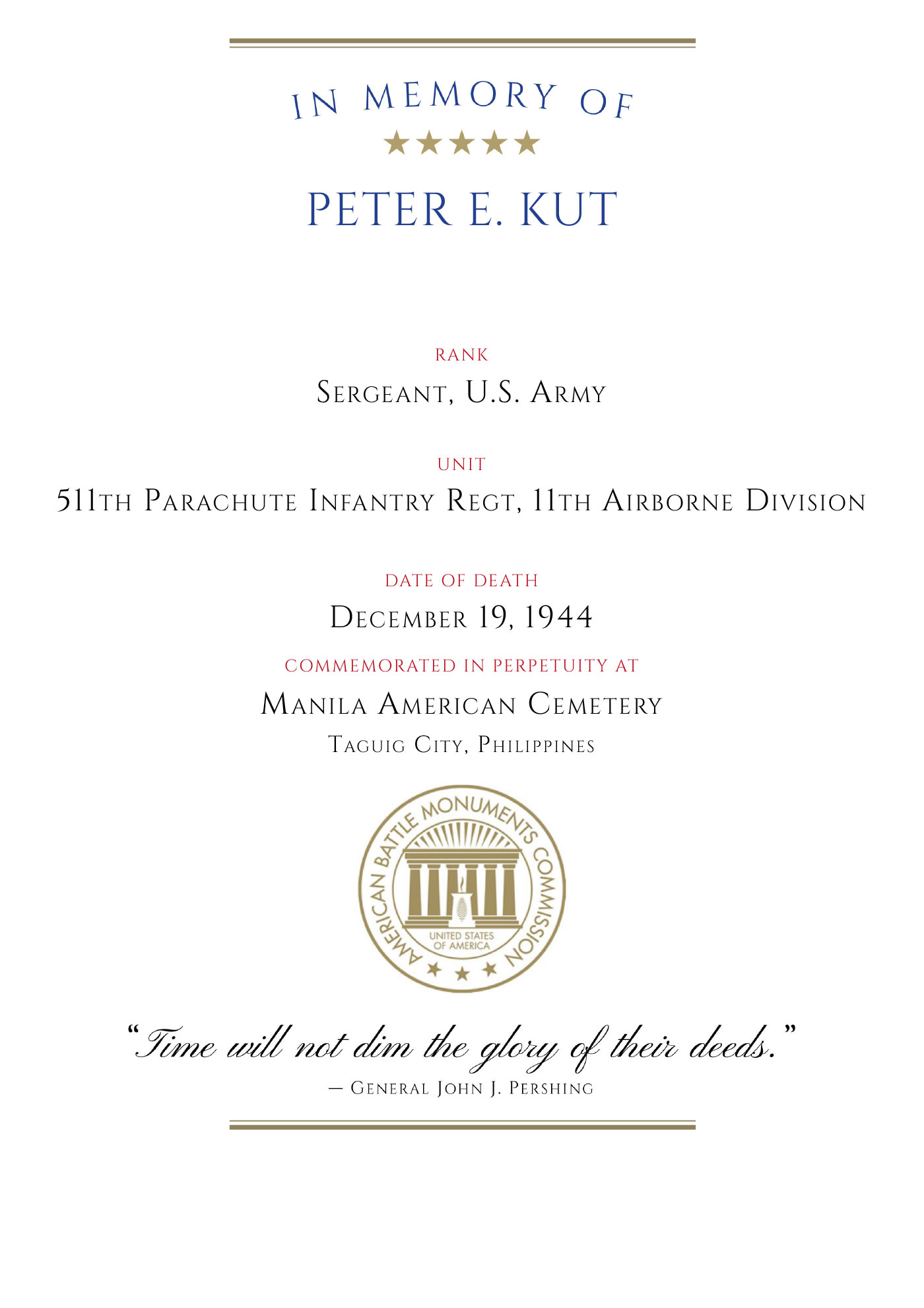
To learn more about the 11th Airborne Division in World War II, please consider purchasing a copy of our books on the Angels:
